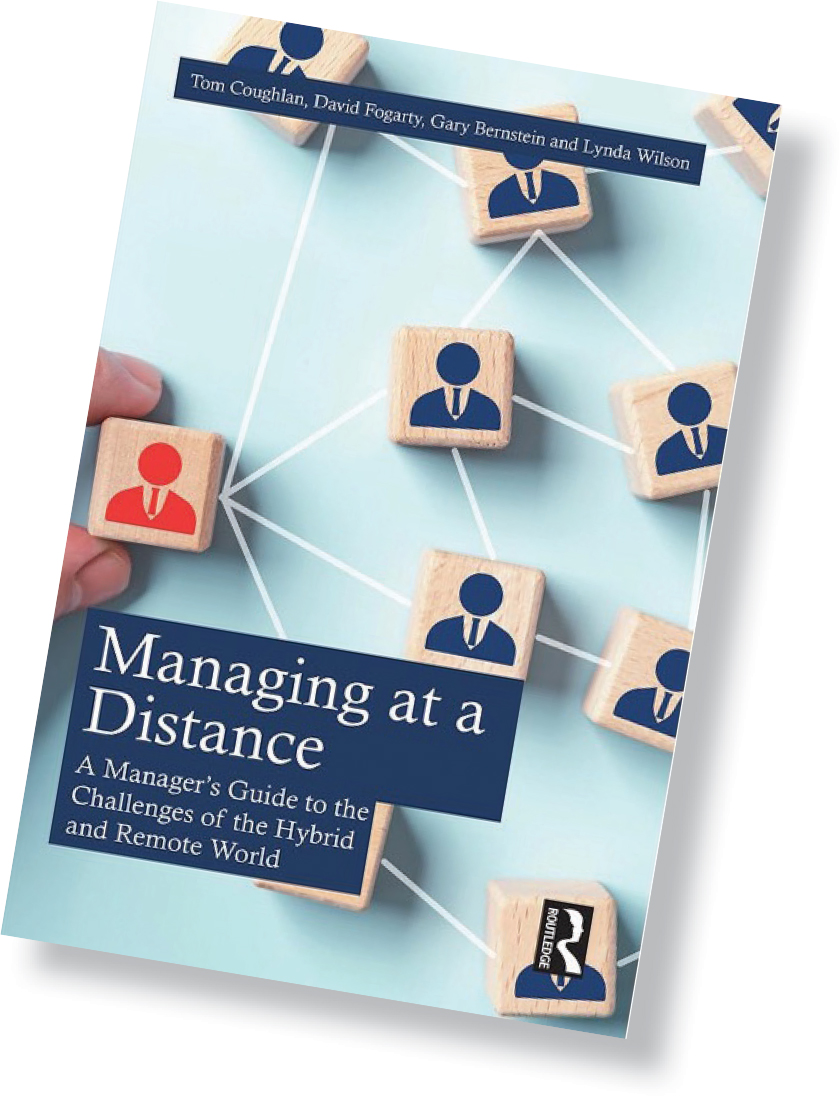

Managing at a Distance
Two business professors offer guidance on remote work.
Q: What inspired you to write the book?
Coughlan: Prior to becoming an academic, I was a marketing communications consultant, and I spent most of my time on the road, so I had lived what some might consider a type of hybrid job for decades. And I worked with global teams, so I understood the challenges of attempting to work together while not sharing either the same physical space or even the same time zone.
It was probably early 2018 that I started to seriously toy with the idea of writing a book about remote management. In 2019, I approached Gary Bernstein, David Fogarty and Lynda Wilson to develop the book. What inspired us was that we recognized that the world had reached an inflection point. That the governance models we relied on for decades, and in some cases centuries, were exhibiting signs of age and entropy. We needed to address social, economic and technical changes that are now, and for the foreseeable future, will be continually redefining our age, and affecting the success of our organizations.
Bernstein: I found it exciting to be able to contribute to a highly contemporary business topic that has become so important in business today and will be more so in the future.
Q: What are some of the challenges of managing employees working remotely?
Coughlan: When I spoke to senior executives while developing the book, the big issues they were concerned about were culture, mentoring, innovation and engagement. Then they worried about how this would affect their strategy going forward on staffing, real estate, recruitment and retention. It is harder (not impossible) to lead culture remotely. So, managers and leaders need to be more deliberate in how they manage their culture because the tacit experience of the culture is more difficult to manage.
Bernstein: A lot remains to be learned on how remoteness of a workforce will impact the ability to develop top senior leaders in the future. Some of the greatest challenges that are already apparent in the workplace do not have easy answers, including the matter of equity between employees that are able and allowed to work remotely versus employees that need a physical presence in the workplace. It will take time until compensation and benefits packages catch up to these types of issues.
Q: What tips can you offer for engaging with employees in today’s hybrid and remote world?
Coughlan: The first issue is to understand that there is no going back to the way it was before.
We need to recognize that the office is simply a tool to facilitate a process. In discussion with a number of commercial real estate executives, we have found that many organizations are rethinking the size, location and layout of their office spaces. There are fewer private offices and more team spaces.
We dedicate a lot of space in the book to the concept of proximity — defining it as more than just geographic closeness and more as an emotional connection between team members. And proximity affects the flow of information between members of an organization. So having an effective proximity strategy becomes critically important.
Bernstein: The top three issues for engaging a hybrid or remote workforce are 1. communication, 2. communication and 3. communication. Once we get past that, there are a myriad of best practices to focus on such as creating a virtual teamwork environment using technology to bring in a feel if not the same, but similar to the workplace and learning how to truly shift away from evaluating work on time and focusing on results. We also need to allow employees to earn trust and leaders in turn need to give a level of trust toward employees, such that remote employees are and feel equally valued.
Q: Do you believe remote and hybrid work will become more widely accepted across industries? Coughlan: Without question, hybrid and remote have become mainstream, but those hybrid and remote workers are not evenly distributed. It is far more common to be hybrid or remote in IT and finance than it is in transportation and hospitality.
Bernstein: It must become more accepted as employees will demand it. There is also the stronger generational pull of younger employees having an even greater preference for remote and hybrid approaches. In a business marketplace where knowledge-based employees and top skills are in both short supply and of paramount importance, this acceptance must happen if an enterprise wants to attract the best talent.
Q: As you both teach in Mercy’s School of Business, has the pandemic or the world after it changed the way you prepare students for the workplace once they graduate?
Coughlan: The pandemic was an inflection point. But the changes we’ve experienced were evident long before the pandemic happened. So, a better way to answer the question might be that managers and organizational leaders can never remain static for very long — especially when they see a shift in the rate of change.
Bernstein: If I had to attribute two aspects to change in preparation, it would be the need to help students first learn the power of communication with all, but especially remote employees, and expand their viewpoint of the role that leaders must take in accepting, embracing and extracting the very best from a new reality.

 School of Business associate professor Tom Coughlan, D.B.A., and Gary Bernstein, M.B.A., C.P.A., Mercy trustee and senior instructor, have co-written a book to offer guidance on remote and hybrid work. “Managing at a Distance: A Manager’s Guide to the Challenges of the Hybrid and Remote World,” published in February 2024, provides simple tools to help managers and leaders find their way. Coughlan and Bernstein, who presented their book to faculty, students and staff at Mercy’s Westchester Campus this spring, offered the Magazine some insight into the book.
School of Business associate professor Tom Coughlan, D.B.A., and Gary Bernstein, M.B.A., C.P.A., Mercy trustee and senior instructor, have co-written a book to offer guidance on remote and hybrid work. “Managing at a Distance: A Manager’s Guide to the Challenges of the Hybrid and Remote World,” published in February 2024, provides simple tools to help managers and leaders find their way. Coughlan and Bernstein, who presented their book to faculty, students and staff at Mercy’s Westchester Campus this spring, offered the Magazine some insight into the book.